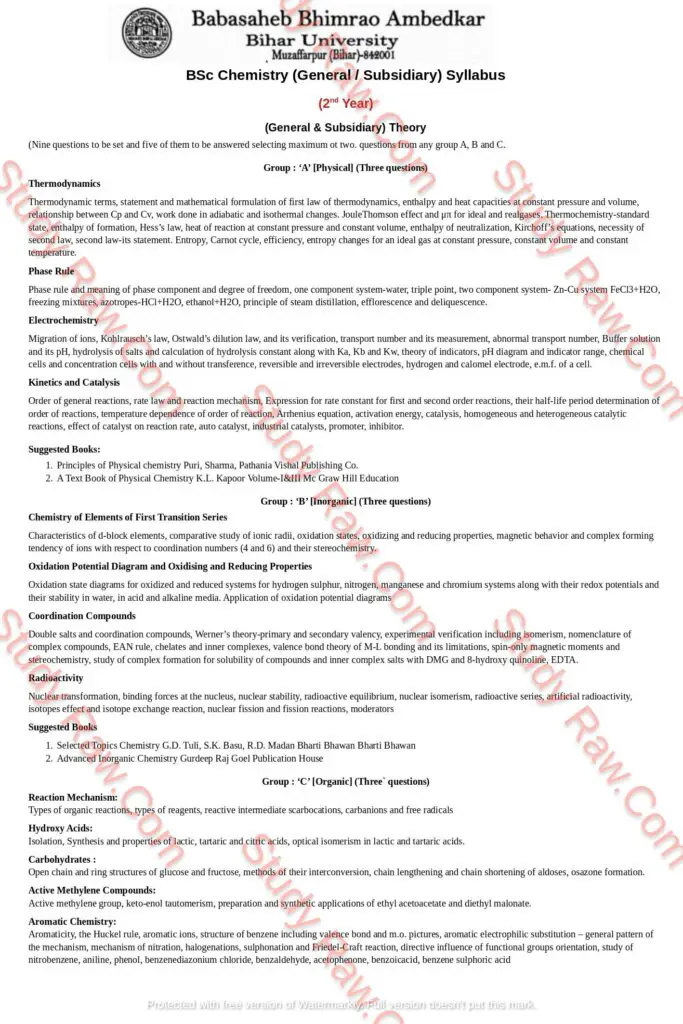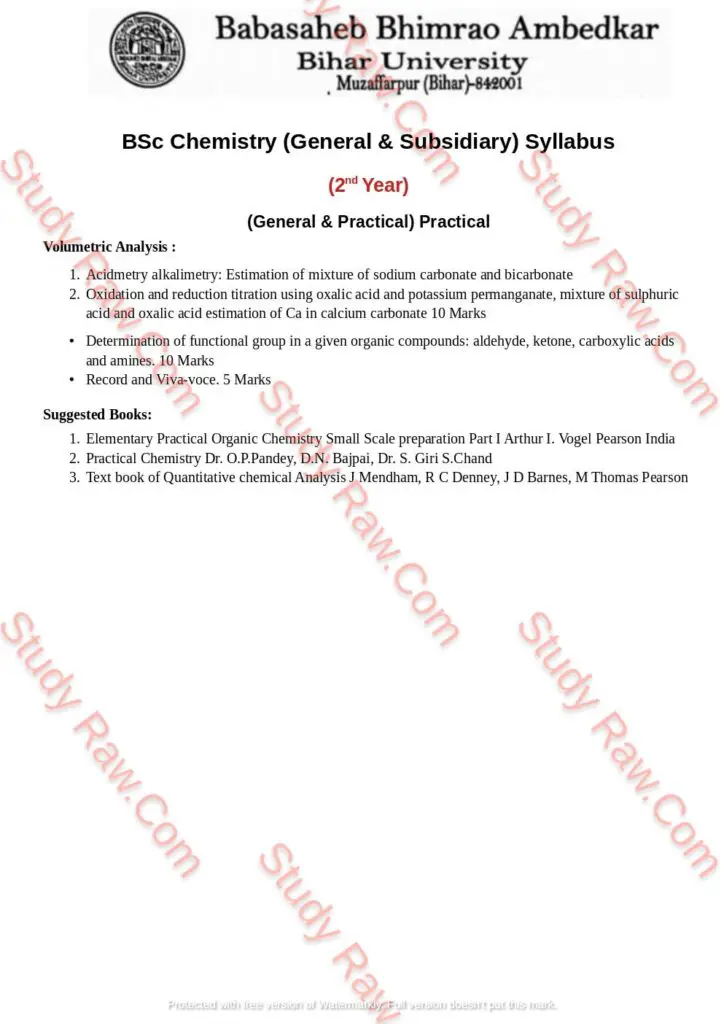BRABU BSc Chemistry 2nd Year Syllabus/ General/ Subsidiary
BRABU BSc Chemistry 2nd Year Syllabus/ General/ Subsidiary: Here we are writing all the UG (BA/ BSc / BCom) Syllabus of Babasaheb Bhimrao Ambedkar Bihar University. So All those students who are studding under this BRABU Bihar University can get their All Subjects Syllabus from this Website- www.studyorigin.in
Here we are providing you BSc Chemistry 2nd Year General and Subsidiary Paper Syllabus. This General and Subsidiary Paper is used to study in 2nd Year of BSc Honors Subject. About total 100 Marks Questions will be asked in their Examination.
BRABU BSc Chemistry (Genera & Subsidiary) Part-2 Syllabus Details-
| University Name | Babasaheb Bhimrao Ambedkar Bihar University |
| Notice About | BSc Chemistry Part-2 Syllabus |
| Paper Number | General & Subsidiary |
| Paper Type | Theory and Practical |
| Academic Year | 2nd Year |
BRABU BSc Chemistry Part-2 (General & Subsidiary) Syllabus
Nine questions to be set and five of them to be answered selecting maximum ot two. questions from any group A, B and C.
Group : ‘A’ [Physical] (Three questions)
Thermodynamics
Thermodynamic terms, statement and mathematical formulation of first law of thermodynamics, enthalpy and heat capacities at constant pressure and volume, relationship between Cp and Cv, work done in adiabatic and isothermal changes. JouleThomson effect and μπ for ideal and realgases. Thermochemistry-standard state, enthalpy of formation, Hess’s law, heat of reaction at constant pressure and constant volume, enthalpy of neutralization, Kirchoff’s equations, necessity of second law, second law-its statement. Entropy, Carnot cycle, efficiency, entropy changes for an ideal gas at constant pressure, constant volume and constant temperature.
Phase Rule
Phase rule and meaning of phase component and degree of freedom, one component system-water, triple point, two component system- Zn-Cu system FeCl3+H2O, freezing mixtures, azotropes-HCl+H2O, ethanol+H2O, principle of steam distillation, efflorescence and deliquescence.
Electrochemistry
Migration of ions, Kohlrausch’s law, Ostwald’s dilution law, and its verification, transport number and its measurement, abnormal transport number, Buffer solution and its pH, hydrolysis of salts and calculation of hydrolysis constant along with Ka, Kb and Kw, theory of indicators, pH diagram and indicator range, chemical cells and concentration cells with and without transference, reversible and irreversible electrodes, hydrogen and calomel electrode, e.m.f. of a cell.
Kinetics and Catalysis
Order of general reactions, rate law and reaction mechanism, Expression for rate constant for first and second order reactions, their half-life period determination of order of reactions, temperature dependence of order of reaction, Arrhenius equation, activation energy, catalysis, homogeneous and heterogeneous catalytic reactions, effect of catalyst on reaction rate, auto catalyst, industrial catalysts, promoter, inhibitor.
Suggested Books:
- Principles of Physical chemistry Puri, Sharma, Pathania Vishal Publishing Co.
- A Text Book of Physical Chemistry K.L. Kapoor Volume-I&III Mc Graw Hill Education
Group : ‘B’ [Inorganic] (Three questions)
Chemistry of Elements of First Transition Series
Characteristics of d-block elements, comparative study of ionic radii, oxidation states, oxidizing and reducing properties, magnetic behavior and complex forming tendency of ions with respect to coordination numbers (4 and 6) and their stereochemistry.
Oxidation Potential Diagram and Oxidising and Reducing Properties
Oxidation state diagrams for oxidized and reduced systems for hydrogen sulphur, nitrogen, manganese and chromium systems along with their redox potentials and their stability in water, in acid and alkaline media. Application of oxidation potential diagrams
Coordination Compounds
Double salts and coordination compounds, Werner’s theory-primary and secondary valency, experimental verification including isomerism, nomenclature of complex compounds, EAN rule, chelates and inner complexes, valence bond theory of M-L bonding and its limitations, spin-only magnetic moments and stereochemistry, study of complex formation for solubility of compounds and inner complex salts with DMG and 8-hydroxy quinoline, EDTA.
Radioactivity
Nuclear transformation, binding forces at the nucleus, nuclear stability, radioactive equilibrium, nuclear isomerism, radioactive series, artificial radioactivity, isotopes effect and isotope exchange reaction, nuclear fission and fission reactions, moderators
Suggested Books
- Selected Topics Chemistry G.D. Tuli, S.K. Basu, R.D. Madan Bharti Bhawan Bharti Bhawan
- Advanced Inorganic Chemistry Gurdeep Raj Goel Publication House
Group : ‘C’ [Organic] (Three` questions)
Reaction Mechanism:
Types of organic reactions, types of reagents, reactive intermediate scarbocations, carbanions and free radicals
Hydroxy Acids:
Isolation, Synthesis and properties of lactic, tartaric and citric acids, optical isomerism in lactic and tartaric acids.
Carbohydrates :
Open chain and ring structures of glucose and fructose, methods of their interconversion, chain lengthening and chain shortening of aldoses, osazone formation.
Active Methylene Compounds:
Active methylene group, keto-enol tautomerism, preparation and synthetic applications of ethyl acetoacetate and diethyl malonate.
Aromatic Chemistry:
Aromaticity, the Huckel rule, aromatic ions, structure of benzene including valence bond and m.o. pictures, aromatic electrophilic substitution – general pattern of the mechanism, mechanism of nitration, halogenations, sulphonation and Friedel-Craft reaction, directive influence of functional groups orientation, study of nitrobenzene, aniline, phenol, benzenediazonium chloride, benzaldehyde, acetophenone, benzoicacid, benzene sulphoric acid
BRABU BSc Chemistry Part-2 Practical for (General / Subsidiary) Syllabus:
Practical Paper
- Volumetric Analysis :
- Acidmetry alkalimetry: Estimation of mixture of sodium carbonate and bicarbonate
- Oxidation and reduction titration using oxalic acid and potassium permanganate, mixture of sulphuric acid and oxalic acid estimation of Ca in calcium carbonate 10 Marks
- Determination of functional group in a given organic compounds: aldehyde, ketone, carboxylic acids and amines. 10 Marks
- Record and Viva-voce. 5 Marks
Suggested Books:
- Elementary Practical Organic Chemistry Small Scale preparation Part I Arthur I. Vogel Pearson India
- Practical Chemistry Dr. O.P.Pandey, D.N. Bajpai, Dr. S. Giri S.Chand
- Text book of Quantitative chemical Analysis J Mendham, R C Denney, J D Barnes, M Thomas Pearson
BRABU BSc Chemistry Part-2 (General & Subsidiary) Marks Distribution:
| BSc Chemistry Part-2 General & Subsidiary | Full Marks: 75 |
| BSc Chemistry Part-2 General & Subsidiary Practical | Full Marks: 25 |
| Exam Time for General & Subsidiary | 3 Hours |
NOTE: Marks Distribution may be different for different University. Please keep confirm by checking previous year Question Paper about Exam Pattern.
BRABU BSc Chemistry Part-2 (General & Subsidiary) Syllabus Image-

BRABU BSc Chemistry Part-2 (General & Subsidiary) Practical Syllabus Image-

Study Origin: Bihar Educational News Social Media –
| Social Media Type | Online Links |
|---|---|
| YouTube | Click here |
| Telegram | Click here |
| Click here | |
| Click here | |
| Facebook Profile | Click here |
| Facebook Page | Click here |
| Facebook Group | Click here |
| Click here |
How many Theory Paper is present in BRABU BSc Chemistry (General & Subsidiary) 2nd Year?
In BSc Chemistry (General & Subsidiary) 2nd Year Students have to study One Theory Paper.
How many Practical Paper is present in BRABU BSc Chemistry (General & Subsidiary) 2nd Year?
There is only one Practical Paper is present in BSc Chemistry (General & Subsidiary) 2nd Year
